HPV infection
HPV infection
overview
HPV infection is a viral infection that often causes skin or mucous membrane growths (warts). There are more than 100 variants of the human papillomavirus (HPV). Some types of HPV infections cause warts, and some can cause various types of cancer.
Most HPV infections do not lead to cancer. However, some types of genital HPV can cause cancer in the lower part of the uterus, which is connected to the vagina (cervix). Other types of cancer, including cancer of the anus, penis, vagina, vulva, and throat (oropharynx), have been linked to HPV infection.
These infections are often transmitted sexually or through other skin-to-skin contact. Vaccines can help protect against the strains of HPV most likely to cause genital warts or cervical cancer.
Symptoms
Common warts
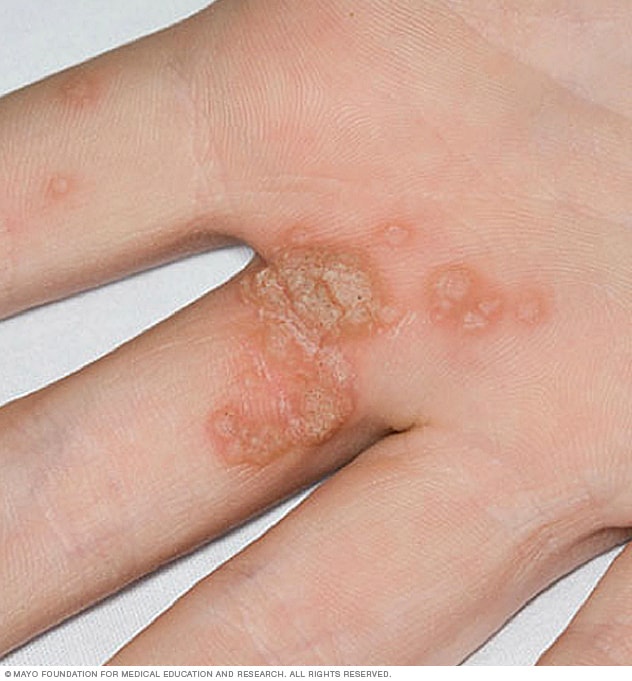
Common warts
Common warts can grow on the hands or fingers. They are small, grainy bumps that feel rough.
Plantar warts
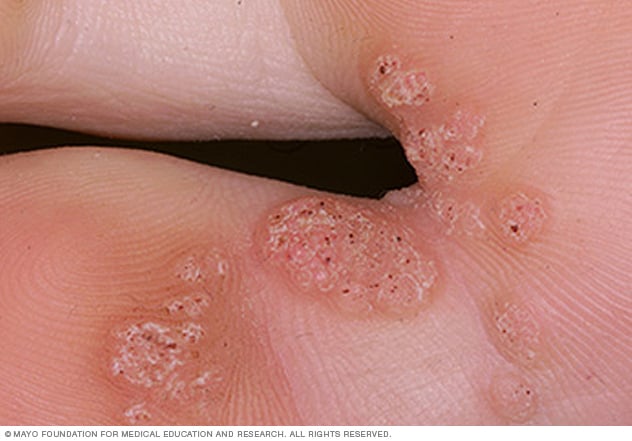
Plantar warts
Plantar warts are caused by the same type of virus that causes warts on the hands and fingers. However, due to their location, they can be painful.
Flat warts
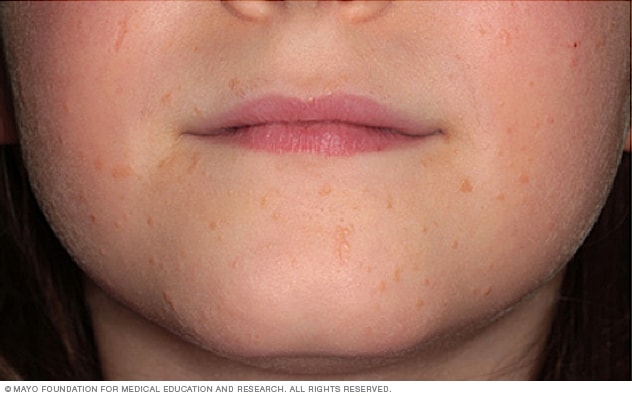
Flat warts
Flat warts are smaller and smoother than other warts. They generally occur on the face or legs and are more common in children and adolescents than adults.
Female genital warts
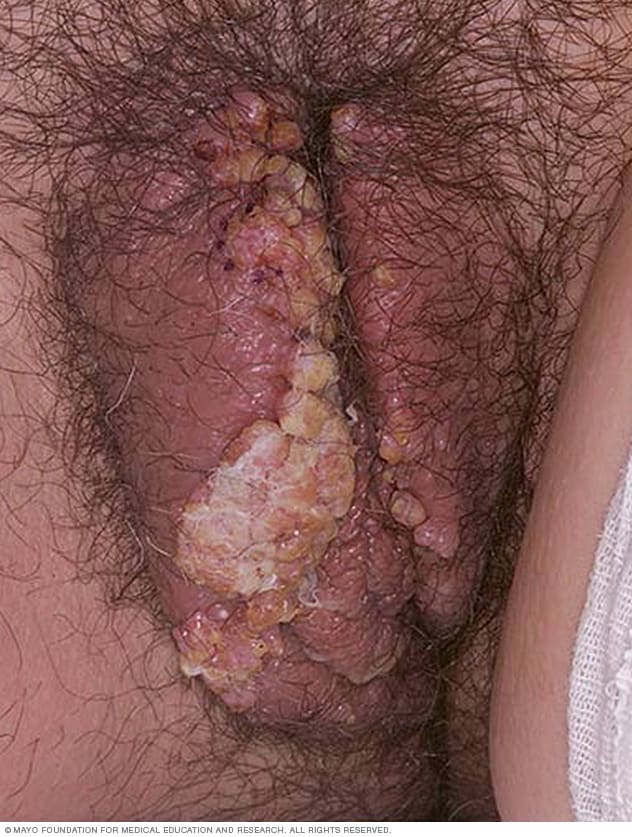
Female genital warts
Genital warts are a common sexually transmitted infection. They can occur on the genitals, pubic area, or anal canal. In women, genital warts can also grow in the vagina.
Male genital warts
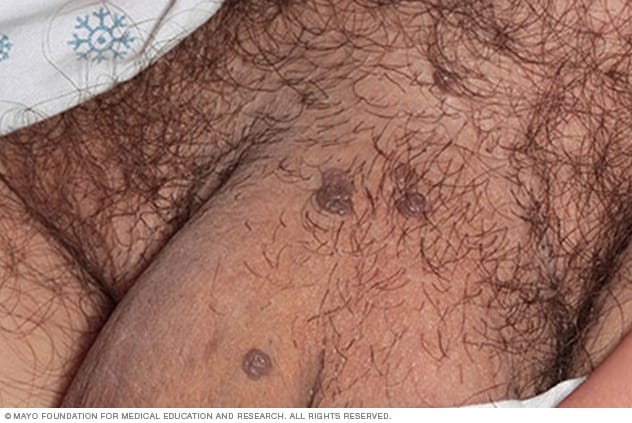
Male genital warts
Genital warts are a common sexually transmitted infection. They can occur on the genitals, pubic area, or anal canal.
In most cases, your body's immune system defeats an HPV infection before warts develop. When warts appear, they differ in appearance depending on what type of HPV they are:
-
Genital warts.These appear as flat lesions, small cauliflower-like bumps, or tiny stalk-like projections. In women, genital warts occur primarily on the vulva, but can also occur near the anus, on the cervix, or in the vagina.
In men, genital warts appear on the penis and scrotum or around the anus. Genital warts rarely cause discomfort or pain, although they may itch or feel tender.
- Gewöhnliche Warzen. Gewöhnliche Warzen erscheinen als raue, erhabene Beulen und treten normalerweise an Händen und Fingern auf. In den meisten Fällen sind gewöhnliche Warzen einfach unansehnlich, aber sie können auch schmerzhaft oder anfällig für Verletzungen oder Blutungen sein.
- Plantar Warzen. Plantarwarzen sind harte, körnige Wucherungen, die normalerweise an den Fersen oder Fußballen auftreten. Diese Warzen können Beschwerden verursachen.
- Flache Warzen. Flache Warzen sind flache, leicht erhabene Läsionen. Sie können überall auftreten, aber Kinder bekommen sie normalerweise im Gesicht und Männer neigen dazu, sie im Bartbereich zu bekommen. Frauen neigen dazu, sie an den Beinen zu bekommen.
cervical cancer
Almost all cervical cancers are caused by HPV infections, but cervical cancer can take 20 years or longer to develop after an HPV infection. HPV infection and early cervical cancer usually do not cause any noticeable symptoms. Vaccination against HPV infection is your best protection against cervical cancer.
Because early-stage cervical cancer does not cause symptoms, it is important that women undergo regular screenings to detect precancerous changes in the cervix that could lead to cancer. Current guidelines recommend that women ages 21 to 29 get a Pap test every three years.
Women aged 30 to 65 are recommended to continue to have a Pap test every three years, or every five years if they also receive the HPV DNA test at the same time. Women over 65 can stop the test if they have had three normal Pap tests in a row or two HPV DNA and Pap tests with no abnormal results.
When to go to the doctor?
If you or your child have warts of any kind that cause you embarrassment, discomfort, or pain, ask your doctor for advice.
Causes
An HPV infection occurs when the virus enters your body, usually through a cut, abrasion, or a small tear in your skin. The virus is transmitted primarily through skin-to-skin contact.
Genital HPV infections are transmitted through sexual intercourse, anal sex, and other skin-to-skin contact in the genital area. Some HPV infections that cause lesions in the mouth or upper respiratory tract are spread through oral sex.
If you are pregnant and have an HPV infection with genital warts, it is possible that your baby will get the infection. In rare cases, the infection can cause a benign growth in the baby's larynx.
Warts are contagious. They can spread through direct contact with a wart. Warts can also spread if someone touches something that has already touched a wart.
Risk factors
HPV infections are common. Risk factors for HPV infection include:
- Anzahl der Sexualpartner. Je mehr Sexualpartner Sie haben, desto wahrscheinlicher ist es, dass Sie sich eine genitale HPV-Infektion zuziehen. Sex mit einem Partner zu haben, der mehrere Sexualpartner hatte, erhöht auch Ihr Risiko.
- Das Alter. Gewöhnliche Warzen treten hauptsächlich bei Kindern auf. Genitalwarzen treten am häufigsten bei Jugendlichen und jungen Erwachsenen auf.
- Geschwächtes Immunsystem. Menschen mit geschwächtem Immunsystem haben ein höheres Risiko für HPV-Infektionen. Das Immunsystem kann durch HIV/AIDS oder durch das Immunsystem unterdrückende Medikamente, die nach Organtransplantationen verwendet werden, geschwächt werden.
- Beschädigte Haut. Durchstochene oder geöffnete Hautbereiche sind anfälliger für gewöhnliche Warzen.
- Persönlicher Kontakt. Das Berühren der Warzen einer anderen Person oder das Nichttragen eines Schutzes vor dem Kontakt mit Oberflächen, die HPV ausgesetzt waren – wie öffentliche Duschen oder Schwimmbäder – kann Ihr Risiko einer HPV-Infektion erhöhen.
Complications
- Verletzungen der Mundhöhle und der oberen Atemwege. Einige HPV-Infektionen verursachen Läsionen auf Ihrer Zunge, Ihren Mandeln, Ihrem weichen Gaumen oder in Ihrem Kehlkopf und Ihrer Nase.
- Krebs. Bestimmte HPV-Stämme können Gebärmutterhalskrebs verursachen. Diese Stämme könnten auch zu Krebserkrankungen der Genitalien, des Anus, des Mundes und der oberen Atemwege beitragen.
prevention
Common warts
It is difficult to prevent HPV infections, which cause common warts. If you have a common wart, you can prevent the infection from spreading and new warts from forming by not picking at a wart or biting your nails.
Plantar warts
To reduce the risk of HPV infection, which causes plantar warts, wear shoes or sandals in public pools and locker rooms.
Genital warts
You can reduce your risk of developing genital warts and other HPV-related genital lesions by:
- In einer gegenseitig monogamen sexuellen Beziehung sein
- Reduzieren Sie die Anzahl Ihrer Sexpartner
- Verwenden Sie ein Latexkondom, das Ihr Risiko einer HPV-Übertragung verringern kann
HPV vaccines
Gardasil 9 is an HPV vaccine approved by the U.S. Food and Drug Administration that can be used for men and women to protect against cervical cancer and genital warts.
The Centers for Disease Control and Prevention (CDC) recommends routine HPV vaccination for girls and boys ages 11 and 12, although it can be given as early as age 9. It is ideal for girls and boys to receive the vaccine before they have sexual contact and are exposed to HPV. Research has shown that vaccination at a young age is not associated with an earlier onset of sexual activity.
Once someone is infected with HPV, the vaccine may not be as effective or may not work at all. In addition, the response to the vaccine is better in younger people than in older people. However, if the vaccine is given before infection, it can prevent most cases of cervical cancer.
The CDC recommends that all 11- and 12-year-olds receive two doses of HPV vaccine at least six months apart. Younger adolescents aged 9 and 10 and teenagers aged 13 and 14 can also be vaccinated using the updated two-dose vaccination schedule. Research has shown that the two-dose regimen is effective for children under 15 years of age.
Adolescents and young adults who start the vaccination series later, aged 15 to 26, should continue to receive three doses of the vaccine.
The CDC recommends catch-up HPV vaccinations for anyone up to age 26 who is not adequately vaccinated.
The US Food and Drug Administration recently approved the use of Gardasil 9 for men and women ages 9 to 45. If you are between 27 and 45 years old, discuss with your doctor whether he or she recommends the HPV vaccination.
Sources:
- Jameson JL, et al., Hrsg. Infektionen mit dem humanen Papillomavirus. In: Harrisons Prinzipien der Inneren Medizin. 20. Aufl. New York, NY: Die McGraw-Hill-Unternehmen; 2018. https://accessmedicine.mhmedical.com. Abgerufen am 25. Februar 2019.
- Bennett JE, et al., Hrsg. Papillomaviren. In: Prinzipien und Praxis von Infektionskrankheiten von Mandell, Douglas und Bennett. 8. Aufl. Philadelphia, Pennsylvania: Elsevier; 2015. https://www.clinicalkey.com. Abgerufen am 25. Februar 2019.
- Warzen. Amerikanische Akademie für Dermatologie. https://www.aad.org/public/diseases/contagious-skin-diseases/warts. Abgerufen am 20. Februar 2019.
- Fragen Sie MayoExpert. Impfung gegen humanes Papillomavirus (HPV). Rochester, Minnesota: Mayo Foundation for Medical Education and Research; 2018.
- HPV-Impfstoff. Zentren für die Kontrolle und Prävention von Krankheiten. https://www.cdc.gov/hpv/parents/vaccine-for-hpv.html. Abgerufen am 6. Oktober 2021.
- Fragen Sie MayoExpert. Anogenitale Warzen. Rochester, Minnesota: Mayo Foundation for Medical Education and Research; 2018.
- Humanes Papillomavirus (HPV) und Gebärmutterhalskrebs. Weltgesundheitsorganisation. https://www.who.int/en/news-room/fact-sheets/detail/human-papillomavirus-(hpv)-and-cervical-cancer. Abgerufen am 20. Februar 2019.
- Palefsky JM. Humane Papillomavirus-Infektionen: Epidemiologie und Krankheitsassoziationen. https://www.uptodate.com/contents/search. Abgerufen am 25. Februar 2019.
- Die FDA genehmigt die erweiterte Verwendung von Gardasil 9 für Personen im Alter von 27 bis 45 Jahren. US Food and Drug Administration. https://www.fda.gov/newsevents/newsroom/pressannouncements/ucm622715.htm. Abgerufen am 20. Februar 2019.
- Häufig gestellte Fragen. Gynäkologische Probleme FAQ 187. Anormale Testergebnisse zur Früherkennung von Gebärmutterhalskrebs. American College of Geburtshelfer und Gynäkologen. https://www.acog.org/Patients/FAQs/Abnormal-Cervical-Cancer-Screening-Test-Results. Abgerufen am 4. März 2019.
- Zeitplan und Dosierung der HPV-Impfung. Zentren für die Kontrolle und Prävention von Krankheiten. https://www.cdc.gov/hpv/hcp/schedules-recommendations.html?CDC_. Abgerufen am 6. Oktober 2021.
- Impfung gegen humane Papillomviren (HPV): Was jeder wissen sollte. Zentren für die Kontrolle und Prävention von Krankheiten. https://www.cdc.gov/vaccines/vpd/hpv/public/index.html. Abgerufen am 6. Oktober 2021.

 Suche
Suche
 Mein Konto
Mein Konto